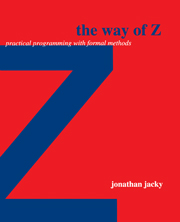Book contents
- Frontmatter
- Contents
- Preface
- I Why Z?
- II Introducing Z
- III Elements of Z
- IV Studies in Z
- 16 Document control system
- 17 Text processing
- 18 Eight queens
- 19 Computer graphics and computational geometry
- 20 Rule-based programming
- 21 Graphical user interface
- 22 Safety-critical protection system
- 23 Modelling large systems
- 24 Object-oriented programming
- 25 Concurrency and real time
- Further reading
- V Programming with Z
- Further reading
- A Glossary of Z notation
- B Omitted features
- C Operator precedence
- D The Z mathematical tool-kit
- E Selected Laws
- F Solutions to selected exercises
- G Other formal notations
- Bibliography
- Index
24 - Object-oriented programming
Published online by Cambridge University Press: 06 July 2010
- Frontmatter
- Contents
- Preface
- I Why Z?
- II Introducing Z
- III Elements of Z
- IV Studies in Z
- 16 Document control system
- 17 Text processing
- 18 Eight queens
- 19 Computer graphics and computational geometry
- 20 Rule-based programming
- 21 Graphical user interface
- 22 Safety-critical protection system
- 23 Modelling large systems
- 24 Object-oriented programming
- 25 Concurrency and real time
- Further reading
- V Programming with Z
- Further reading
- A Glossary of Z notation
- B Omitted features
- C Operator precedence
- D The Z mathematical tool-kit
- E Selected Laws
- F Solutions to selected exercises
- G Other formal notations
- Bibliography
- Index
Summary
Object-oriented programming is a method for creating programs that use a particular kind of model. Object-oriented programming languages such as Smalltalk and C++ can implement these models, but a simpler notation that is independent of any programming language is more useful when you are creating and analyzing the models. Z can serve as that notation. You can do object-oriented design in ordinary Z, and there are several Z dialects that are intended to provide better support for object-oriented programming.
The object-oriented model and Z
The data in an object-oriented program are encapsulated in record-like data structures called objects. Objects belong to types called classes. You change or examine the data in an object, called its attributes or instance variables, by invoking one of the methods defined for the object's class.
Z is a good match to this object-oriented model. A Z state schema together with the operation schemas on that state define a class. The state variables in the state schema are the attributes or instance variables of that class; the operation schemas are the methods. Bindings, which are instances of the state schema type, are objects, which are instances of the class.
The cyclotron control sytem model in Chapter 23 can be considered an object-oriented design in this sense. All the data are encapsulated in objects, and the only way to read or change any data is by invoking a method.
- Type
- Chapter
- Information
- The Way of ZPractical Programming with Formal Methods, pp. 231 - 233Publisher: Cambridge University PressPrint publication year: 1996

